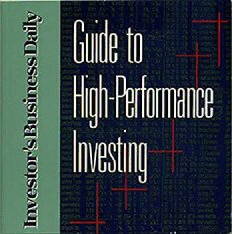Table Of ContentbuiUe to
w~~-r~rf~rm~~~~
.
nvest1n~
By the Edito s of
Investor's Busine s Daily
© 1997, Investor's Business Daily, Inc.
ALL RIGHTS RESERVED. No part of this publication may be
reproduced, stored in a retrieval system, or transmitted by any
means, electronic, mechanical, photocopying, recording, or oth
erwise, without the prior written permission of the publisher
and the copyright holder.
This publication is designed to provide accurate and authorita
tive information in regard to the subject matter covered. It is
sold with the understanding that the publisher is not engaged
in rendering legal, accounding or other professional service.
Cover design by Steve Hodowsky
Printed in the United States of America
by
O'Neil Data Systems, Inc.
12655 Beatrice Street
Los Angeles, California 90066-7003
2 3 4 5 6 7 8 9 0
Contents
Preface v
I. General Market In icators
Market Indexes 3
Moving Averages 7
Advance-Decline Lines 13
Boldfacing In Stock Tables 17
Ticker Tape Reading 19
Ticker Tape Study 23
World Stock Markets 25
II. Psychological Marke Indicators
Bearish/Bullish Sentiment 29
Odd-Lot Short Sales 33
Public/NYSE Specialist Short Sales 35
Short Interest Ratio 37
Mutual Fund Buys, Redemptions 40
OTC Vs. NYSE Trading Volume 43
Stock Splits 46
New Issue Activity 48
Valuing The Dow 51
iii
Ill. Stock Analysis
Earnings Per Share Rank 55
Relative Strength 58
Accumulation-Distribution Rating 61
Volume Percent Change 64
Stock Moving Averages 67
'Stocks In The News' Charts 70
Investor's Weekend Review 76
Stochastic Oscillators 79
IV. Investment Strategy
Valuing Growth Stocks 85
Industry Prices 89
Earnings Season 91
Earnings Reports 93
Largest % Increase In Volume 97
Price-Earnings Ratios 99
Forward-Looking P-Es 103
Timing Transactions 107
Good Publicity Ill
V. Mutual Funds
Mutual Fund Snapshots 117
Mutual Fund Cash Position 120
Index 123
iv
Preface
When asked what Investor's Busine s Daily has that other
newspapers don't, I often have to sto and think. It's not that
examples don't readily come to min . It's that there are so
many I don't know where to begin. o, I often find myself
answering: "How much time do I have?"
On such occasions I'm also reminde how formidable a task
it is for readers to understand all that's ·n the paper and how to
use it to their advantage. Over the yea s, we've produced vari
ous pamphlets, tapes and books to elp with the learning
process. But the questions keep coming
In the paper itself, we've run two s ries of explanatory fea
tures-one in 1987-88 called "Inside l vestor's Daily" and the
other in 1989-90 called "Educating In estors" (a feature we
resumed in late 1992). We got a lot of p sitive feedback on both
series, and many readers have asked fo reprints.
This book is a compilation of many a tides from those series.
We've made a special effort to include a tides on those features
in the paper that generate the most qu stions, such as how to
interpret the "Psychological Market In icators" on the General
Market Indicators page.
Most of the articles were written by Leo Fasciocco, dean of
U.S. stock-market writers, who also wri es our daily "Inside the
Market" column on NYSE action. Exam les used in his original
stories have been updated where nece sary. The charts are by
Alan Hoffman, our graphics editor.
We hope these articles-many of whi h include insights from
v
America's top market analysts and money managers-will help
make Investor's Business Daily even more useful to our already
loyal readers.
If there is other information you need, or improvements you
would like to see in Investor's Business Daily, please let us know.
We get thousands of suggestions each year. All are given seri
ous consideration, and many find their way into the paper or
our other products.
Wesley F Mann
Editor
vi
I
e
it
1
nUicator~
be ma MarKe.
1¥Cii7N+L4!!1ijj~\\'1&WHt@$~)W
Mark Indexes
t
Fingers On The Puts Of The Broad Market
• Knowing if you're in a In the world of stock market inves ing, a lot of cliches get
bull market or a bear tossed around. Among the classics: " on't fight the tape" and
"the trend is your friend."
market solves half
As with most cliches, these one-lin rs contain more than a
the problem in
shred of truth, especially when it c mes to market activity.
selecting stocks. Experienced investors have come t know that the general
trend of the overall market has a majo influence on the perfor
mance of individual issues.
Knowing if you're in a bull market (r sing prices) or bear mar
ket (declining prices), or even a chop y market (sideways pat
tern with volatility), solves half the pr blem in selecting stocks.
Many experts believe that proper analysis of the market's
trend is 60% of the process of selectin winning stocks.
Because most investors buy long, as opposed to selling short,
it's important to be aware of the differ nee between market cor
rections-5% to 10% declines in an o herwise rising long-term
trend-and dreaded bear markets.
It's been said that in a bear mark t at least three of four
stocks will fall. Another cliche is appr priate here: "When they
raid the house, they get them all."
Analyzing The Market
There are many ways to analyze th stock market. Investor's
Business Daily doesn't promote any particular method. But
knowing the importance of market dat , the newspaper has pro
vided its readers with a wealth of info mation and an attractive
3

